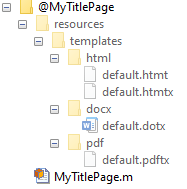Define New Reporters
MATLAB®
Report Generator™ allows you to define a custom reporter based on the mlreportgen.report.Reporter class or a built-in Report API reporter. Base
your reporter on a built-in reporter when the built-in reporter meets most of your
requirements and you want to rearrange or expand the reporter content. See Subclass Reporter Definitions. Base your
reporter on the mlreportgen.report.Reporter class to define an entirely
new reporter.
To create a reporter based on mlreportgen.report.Reporter, use the mlreportgen.report.Reporter.customizeReporter method. The method creates a
skeleton class definition file and makes copies of the default template files for each
report output type.
To complete the custom reporter definition:
In the template file for each report output type supported by the reporter, define the fixed content and holes for the dynamic content that the reporter generates.
In the custom reporter class, define properties that correspond to the template holes.
To use the reporter in a Report API report, create an object of the reporter class, set the property values, and append the object to the report.
Create Class Definition File and Template Copies
Create a class definition file for a custom reporter class and make copies of the
default templates by calling the mlreportgen.report.Reporter.customizeReporter method. Provide the path
and name of the class to be created as the input argument to the method. To create
the reporter class in a class folder, precede the class name with the
@ character.
For example, this code creates a class file MyTitlePage.m in
the folder named
@MyTitlePage:
mlreportgen.report.Reporter.customizeReporter("@MyTitlePage")The class definition file MyTitlePage.m
contains:
classdef MyTitlePage < mlreportgen.report.Reporter properties end methods function obj = MyTitlePage(varargin) obj = obj@mlreportgen.report.Reporter(varargin{:}); end end methods (Hidden) function templatePath = getDefaultTemplatePath(~, rpt) path = MyTitlePage.getClassFolder(); templatePath = ... mlreportgen.report.ReportForm.getFormTemplatePath(... path, rpt.Type); end end methods (Static) function path = getClassFolder() [path] = fileparts(mfilename("fullpath")); end function createTemplate(templatePath, type) path = MyTitlePage.getClassFolder(); mlreportgen.report.ReportForm.createFormTemplate(... templatePath, type, path); end function customizeReporter(toClasspath) mlreportgen.report.ReportForm.customizeClass(... toClasspath, "MyTitlePage"); end end
getDefaultTemplatePath. The base reporter class uses the
getDefaultTemplatePath method to retrieve the
MyTitlePage reporter template that corresponds to the output type
of the report to which the reporter is added. For example, if you add the reporter
to an mlreportgen.report.Report object whose output type is PDF, the
base reporter class returns the path of the PDF template that resides in the
resources/templates/pdf subfolder of your reporter definition
folder.The mlreportgen.report.Reporter.customizeReporter method stores
copies of the default template files for each report output type in the
resources/templates subfolder of the folder that contains the
class definition file. The paths of the template files relative to
resources/templates are:
docx/default.dotxpdf/default.pdftxhtml/default.htmthtml/default.htmtx
For example, the @MyTitlePage folder has this
structure:

Define Fixed and Dynamic Content in Templates
Customize the template files by defining the fixed content and holes for the
dynamic content that the custom reporter generates. You only need to customize the
template files for the report output types supported by the custom reporter. For
example, if the reporter supports only Word reports, customize only the
dotx template file.
If the custom reporter requires multiple templates, store the templates in a
template library in the template file. If the reporter requires only one template,
you can store the template content in the body of the template file or in a template
in the template library. For example, for the MyTitlePage reporter,
which requires only one template, you can add the template fixed content and holes
for dynamic content to the body of the template file or to an entry named
MyTitlePage in the template file library.
Define the styles used by the template in the style sheet of the template file.
See Create Microsoft Word Document Part Template Library, Create PDF Document Part Template Library, and Create HTML Document Part Template Library.
Define Properties and Specify Templates in Custom Reporter Classes
In the custom reporter class:
Define a property for each of the holes defined by the templates, including holes in the headers and footers. The property corresponding to a hole must have the same name as the hole. For example, if the reporter templates define a hole named
Title, the class definition file must define a property namedTitle.If the reporter uses a template stored in the template library of the template file, add a line to the constructor that sets the property
TemplateNameto the name of the reporter template. You do not have to specify this property in the class definition file because the customized class inherits this property from the baseslreportgen.report.Reporterclass.
For example, this class definition file defines Title,
Author, and Version properties and
specifies that the template name is
MyTitlePage
classdef MyTitlePage < mlreportgen.report.Reporter properties Title = ""; Author = ""; Version = ""; end methods function obj = MyTitlePage(varargin) obj = obj@mlreportgen.report.Reporter(varargin{:}); obj.TemplateName = "MyTitlePage"; end end methods (Hidden) function templatePath = getDefaultTemplatePath(~, rpt) path = MyTitlePage.getClassFolder(); templatePath = ... mlreportgen.report.ReportForm.getFormTemplatePath(... path, rpt.Type); end end methods (Static) function path = getClassFolder() [path] = fileparts(mfilename("fullpath")); end function createTemplate(templatePath, type) path = MyTitlePage.getClassFolder(); mlreportgen.report.ReportForm.createFormTemplate(... templatePath, type, path); end function customizeReporter(toClasspath) mlreportgen.report.ReportForm.customizeClass(... toClasspath, "MyTitlePage"); end end end
Use Custom Reporters
To use your custom reporter:
Create an object of the reporter class.
Set the values of the properties that you defined in the class.
Append the object to a report.
For example:
import mlreportgen.report.* rpt = Report("myreport","pdf"); titlePage = MyTitlePage; titlePage.Title = "My Report"; titlePage.Author = "Me"; titlePage.Version = "1.0" append(rpt,titlePage); close(rpt); rptview(rpt);
See Also
mlreportgen.report.TitlePage | mlreportgen.report.Report | mlreportgen.report.TableOfContents | mlreportgen.dom.Text | mlreportgen.dom.Document